6 Gym Machines That Are Actually Worth Your Time
![]() Nearly every gym has two distinct sections—free weights and machines—and they attract different crowds. Serious lifters do their thing with free weights, and weaklings and wannabes stick with the machines. After all, free weights get results and machines are useless, right?
Nearly every gym has two distinct sections—free weights and machines—and they attract different crowds. Serious lifters do their thing with free weights, and weaklings and wannabes stick with the machines. After all, free weights get results and machines are useless, right?
Maybe not. The vilification of machines has become so widespread that athletes might be apt to skip them altogether—which isn’t necessarily a good move.
Although some machines are inefficient, not every machine is a waste of time. A number of machine-based exercises offer tremendous benefits, but they often get unfairly lumped into the whole “machines are worthless” narrative. To ignore them would mean ignoring a unique set of tools that can help you reach your fitness goals. With that in mind, here are the six gym machines that are actually worth your time.
1. Lat Pull-Down Machine
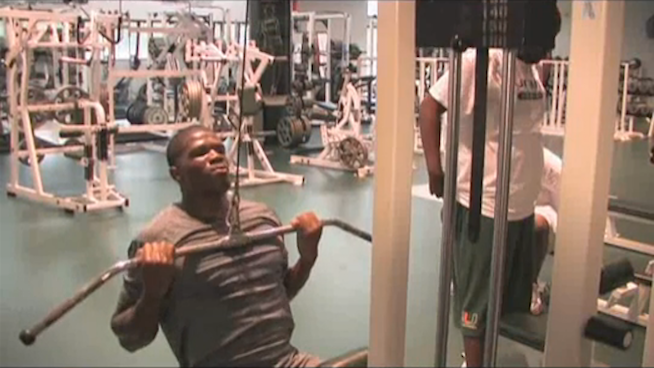
Who’s Using It: Andre Johnson, Dwight Howard
The Lat Pull-Down is a simple but effective movement, which is exactly what you want from a machine-based exercise. The confusing and complicated machines are usually the ones that waste your time. The Lat Pull-Down is a great low-impact exercise for building back strength. If you’re looking to build a wider upper torso, Lat Pull-Downs can help you reach that goal.
If you cannot yet do a substantial number of Pull-Ups (or if a Pull-Up bar is unavailable), Lat Pull-Downs are a good alternative to challenge many of the same muscle groups. Lat Pull-Downs allow you to easily focus on tempo, which can be beneficial for muscle growth. Learn more about tempo training here.
The Lat Pull-Down has a number of potential variations, but you’re best served by starting with a wide, overhanded grip before experimenting with other variations.
How-To: Grab the handle with an overhand grip slightly wider than shoulder-width. Leaning slightly back, pull the handle down toward the top of your chest while keeping your elbows out. Once the handle is nearly at your chest, slowly return to the starting position.
2. Seated Row Machine
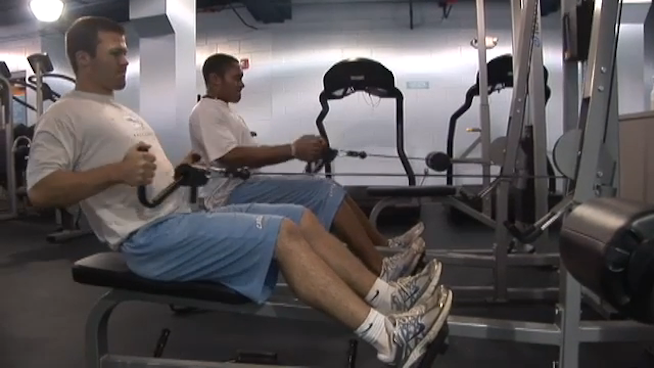
Who’s Using It: Damian Lillard, UNC Baseball
The Seated Cable Row is another machine-based exercise that shouldn’t be overlooked. Like the Lat Pull-Down, it’s simple yet effective. For many people, the Seated Cable Row is a simpler and safer movement than the Bent-Over Barbell Row.
The Bent-Over Barbell Row is a terrific exercise, but poor form can quickly lead to a back injury. The risk of injury with the Seated Cable Row is significantly lower, but it hits many of the same muscle groups. Like the Lat-Pull Down, the Seated Cable Row allows you to focus on your tempo, which is beneficial for building muscle.
How-To: Grab the handle of the Row machine. Get into a position that allows you to lean slightly back throughout the movement. Pull the handle to your sternum, keeping your body stationary and your elbows close to your body. Slowly return to the starting position.
3. Cable Curl Machine
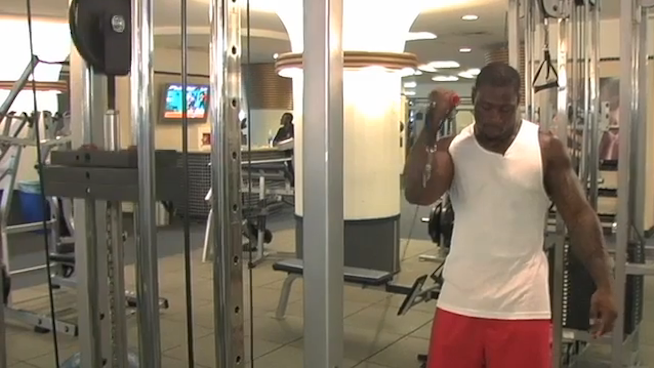
Who’s Using It: Thomas Jones
Although your biceps might not be the most important muscles for athletic performance, everyone’s guilty of wanting big guns. There’s nothing wrong with getting your Hulk Hogan on with biceps-centric exercises—as long as you’re not spending a large amount of time and energy solely working your arms.
If you’re looking to pump up your pythons, the Cable Curl is a phenomenal choice. In a study of eight different biceps-building exercises, the Cable Curl was found to be the second best for biceps brachii muscle activation, beating out the Chin-Up, Barbell Curl and Preacher Curl.
How-To: Grab the handle of the Cable Curl with an underhand grip and relax your arms in front of you. Keeping your elbows stationary, pull the handle toward the top of your chest. Keep your back straight throughout the movement. Once you’ve curled the handle nearly to your chest, slowly return to the starting position.
4. Pec Deck
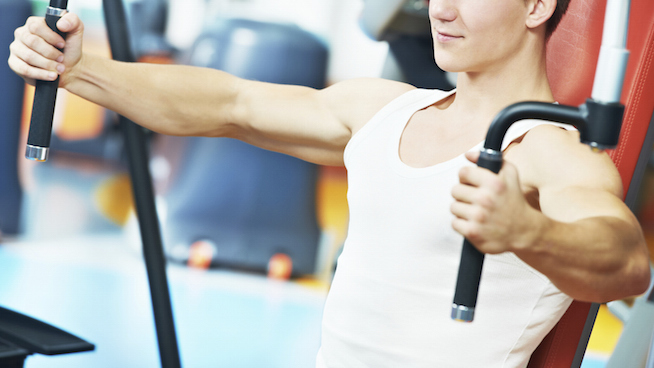
Who’s Using It: The Sacramento Kings
A strong chest is crucial to success in a large number of sports. The biggest muscle in the chest is the pectoralis major, a.k.a. the pec. Building powerful pecs is a top priority for many gym goers, and it turns out several machine-based exercises can help.
In a study of nine different chest-building exercises, the Pec Deck machine was found to be the second best for pec activation. Another machine exercise, the Bent-Forward Cable Crossover, came in third. Both exercises “elicited nearly equalivent muscle activation as the Barbell Bench Press.” The Pec Deck machine scored higher than several popular exercises, including Inclined Dumbbell Flys and Push-Ups.
How-To: Adjust the height of the seat so your hands meet directly in front of your chest. Grab the handles and slowly bring them together in front of you, focusing on targeting your pecs. Slowly return the handles to the starting position.
5. Cable Pull-Through (Performed on a Cable Machine)
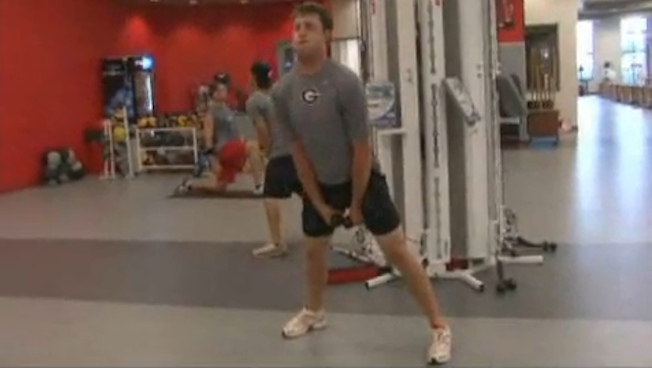
Who’s Using It: Shea McClellin, University of Georgia Basketball
The Cable Pull-Through is a great alternative to the standard Deadlift. Not only is Deadlifting in a crowded gym a real challenge, but the form can be difficult to master and it can take a toll on your back. The Cable Pull-Through is both simpler and less risky than the Deadlift, while challenging many of the same muscle groups.
The Cable Pull-Through is a great exercise for strengthening your posterior chain. A strong posterior chain plays a key role in many major athletic movements such as sprinting and jumping. Read more about the rise of the Cable Pull-Through here.
How-To: Begin with your back to a cable machine and your feet hip-width apart. Hold the rope attachment in front of your hips so the cable travels between your legs. Bend at the waist and push your hips back until your torso reaches a 45-degree angle. Extend your hips explosively to pull the cable through and return to the starting position.
6. Single-Leg Press (Performed on a Leg Press Machine)
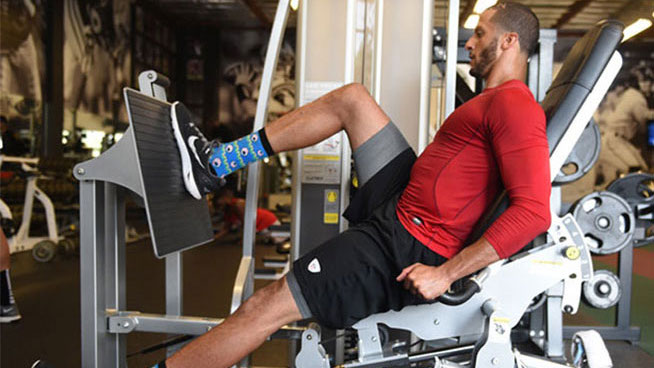
Who’s Using It: Colin Kaepernick, Quintin Mikell
The leg press is a controversial machine. Some people think it’s useful, others think it’s a waste of time. The value of traditional Leg Press exercises will always be debated, but the Single-Leg Press is a variation that’s unquestionably beneficial.
The Single-Leg Press isolates the glutes and hamstrings. The exercise is an example of unilateral training, meaning it combats muscle imbalances and ensures both sides of your body are equal in strength. The single-leg Leg Press variation may translate better to sports than the traditional Leg Press, since athletes often have to jump, cut and perform other movements off one leg.
How-To: Adjust the seat so that your legs form a 90-degree angle in the starting position. Put your right leg slightly right of the middle of the foot plate. Push through your heel to move the load, focusing on targeting your glute, hamstring and quad. Once your leg is fully extended, slowly return to the starting position.
RECOMMENDED FOR YOU
MOST POPULAR
6 Gym Machines That Are Actually Worth Your Time
![]() Nearly every gym has two distinct sections—free weights and machines—and they attract different crowds. Serious lifters do their thing with free weights, and weaklings and wannabes stick with the machines. After all, free weights get results and machines are useless, right?
Nearly every gym has two distinct sections—free weights and machines—and they attract different crowds. Serious lifters do their thing with free weights, and weaklings and wannabes stick with the machines. After all, free weights get results and machines are useless, right?
Maybe not. The vilification of machines has become so widespread that athletes might be apt to skip them altogether—which isn’t necessarily a good move.
Although some machines are inefficient, not every machine is a waste of time. A number of machine-based exercises offer tremendous benefits, but they often get unfairly lumped into the whole “machines are worthless” narrative. To ignore them would mean ignoring a unique set of tools that can help you reach your fitness goals. With that in mind, here are the six gym machines that are actually worth your time.
1. Lat Pull-Down Machine

Who’s Using It: Andre Johnson, Dwight Howard
The Lat Pull-Down is a simple but effective movement, which is exactly what you want from a machine-based exercise. The confusing and complicated machines are usually the ones that waste your time. The Lat Pull-Down is a great low-impact exercise for building back strength. If you’re looking to build a wider upper torso, Lat Pull-Downs can help you reach that goal.
If you cannot yet do a substantial number of Pull-Ups (or if a Pull-Up bar is unavailable), Lat Pull-Downs are a good alternative to challenge many of the same muscle groups. Lat Pull-Downs allow you to easily focus on tempo, which can be beneficial for muscle growth. Learn more about tempo training here.
The Lat Pull-Down has a number of potential variations, but you’re best served by starting with a wide, overhanded grip before experimenting with other variations.
How-To: Grab the handle with an overhand grip slightly wider than shoulder-width. Leaning slightly back, pull the handle down toward the top of your chest while keeping your elbows out. Once the handle is nearly at your chest, slowly return to the starting position.
2. Seated Row Machine

Who’s Using It: Damian Lillard, UNC Baseball
The Seated Cable Row is another machine-based exercise that shouldn’t be overlooked. Like the Lat Pull-Down, it’s simple yet effective. For many people, the Seated Cable Row is a simpler and safer movement than the Bent-Over Barbell Row.
The Bent-Over Barbell Row is a terrific exercise, but poor form can quickly lead to a back injury. The risk of injury with the Seated Cable Row is significantly lower, but it hits many of the same muscle groups. Like the Lat-Pull Down, the Seated Cable Row allows you to focus on your tempo, which is beneficial for building muscle.
How-To: Grab the handle of the Row machine. Get into a position that allows you to lean slightly back throughout the movement. Pull the handle to your sternum, keeping your body stationary and your elbows close to your body. Slowly return to the starting position.
3. Cable Curl Machine

Who’s Using It: Thomas Jones
Although your biceps might not be the most important muscles for athletic performance, everyone’s guilty of wanting big guns. There’s nothing wrong with getting your Hulk Hogan on with biceps-centric exercises—as long as you’re not spending a large amount of time and energy solely working your arms.
If you’re looking to pump up your pythons, the Cable Curl is a phenomenal choice. In a study of eight different biceps-building exercises, the Cable Curl was found to be the second best for biceps brachii muscle activation, beating out the Chin-Up, Barbell Curl and Preacher Curl.
How-To: Grab the handle of the Cable Curl with an underhand grip and relax your arms in front of you. Keeping your elbows stationary, pull the handle toward the top of your chest. Keep your back straight throughout the movement. Once you’ve curled the handle nearly to your chest, slowly return to the starting position.
4. Pec Deck

Who’s Using It: The Sacramento Kings
A strong chest is crucial to success in a large number of sports. The biggest muscle in the chest is the pectoralis major, a.k.a. the pec. Building powerful pecs is a top priority for many gym goers, and it turns out several machine-based exercises can help.
In a study of nine different chest-building exercises, the Pec Deck machine was found to be the second best for pec activation. Another machine exercise, the Bent-Forward Cable Crossover, came in third. Both exercises “elicited nearly equalivent muscle activation as the Barbell Bench Press.” The Pec Deck machine scored higher than several popular exercises, including Inclined Dumbbell Flys and Push-Ups.
How-To: Adjust the height of the seat so your hands meet directly in front of your chest. Grab the handles and slowly bring them together in front of you, focusing on targeting your pecs. Slowly return the handles to the starting position.
5. Cable Pull-Through (Performed on a Cable Machine)

Who’s Using It: Shea McClellin, University of Georgia Basketball
The Cable Pull-Through is a great alternative to the standard Deadlift. Not only is Deadlifting in a crowded gym a real challenge, but the form can be difficult to master and it can take a toll on your back. The Cable Pull-Through is both simpler and less risky than the Deadlift, while challenging many of the same muscle groups.
The Cable Pull-Through is a great exercise for strengthening your posterior chain. A strong posterior chain plays a key role in many major athletic movements such as sprinting and jumping. Read more about the rise of the Cable Pull-Through here.
How-To: Begin with your back to a cable machine and your feet hip-width apart. Hold the rope attachment in front of your hips so the cable travels between your legs. Bend at the waist and push your hips back until your torso reaches a 45-degree angle. Extend your hips explosively to pull the cable through and return to the starting position.
6. Single-Leg Press (Performed on a Leg Press Machine)

Who’s Using It: Colin Kaepernick, Quintin Mikell
The leg press is a controversial machine. Some people think it’s useful, others think it’s a waste of time. The value of traditional Leg Press exercises will always be debated, but the Single-Leg Press is a variation that’s unquestionably beneficial.
The Single-Leg Press isolates the glutes and hamstrings. The exercise is an example of unilateral training, meaning it combats muscle imbalances and ensures both sides of your body are equal in strength. The single-leg Leg Press variation may translate better to sports than the traditional Leg Press, since athletes often have to jump, cut and perform other movements off one leg.
How-To: Adjust the seat so that your legs form a 90-degree angle in the starting position. Put your right leg slightly right of the middle of the foot plate. Push through your heel to move the load, focusing on targeting your glute, hamstring and quad. Once your leg is fully extended, slowly return to the starting position.











